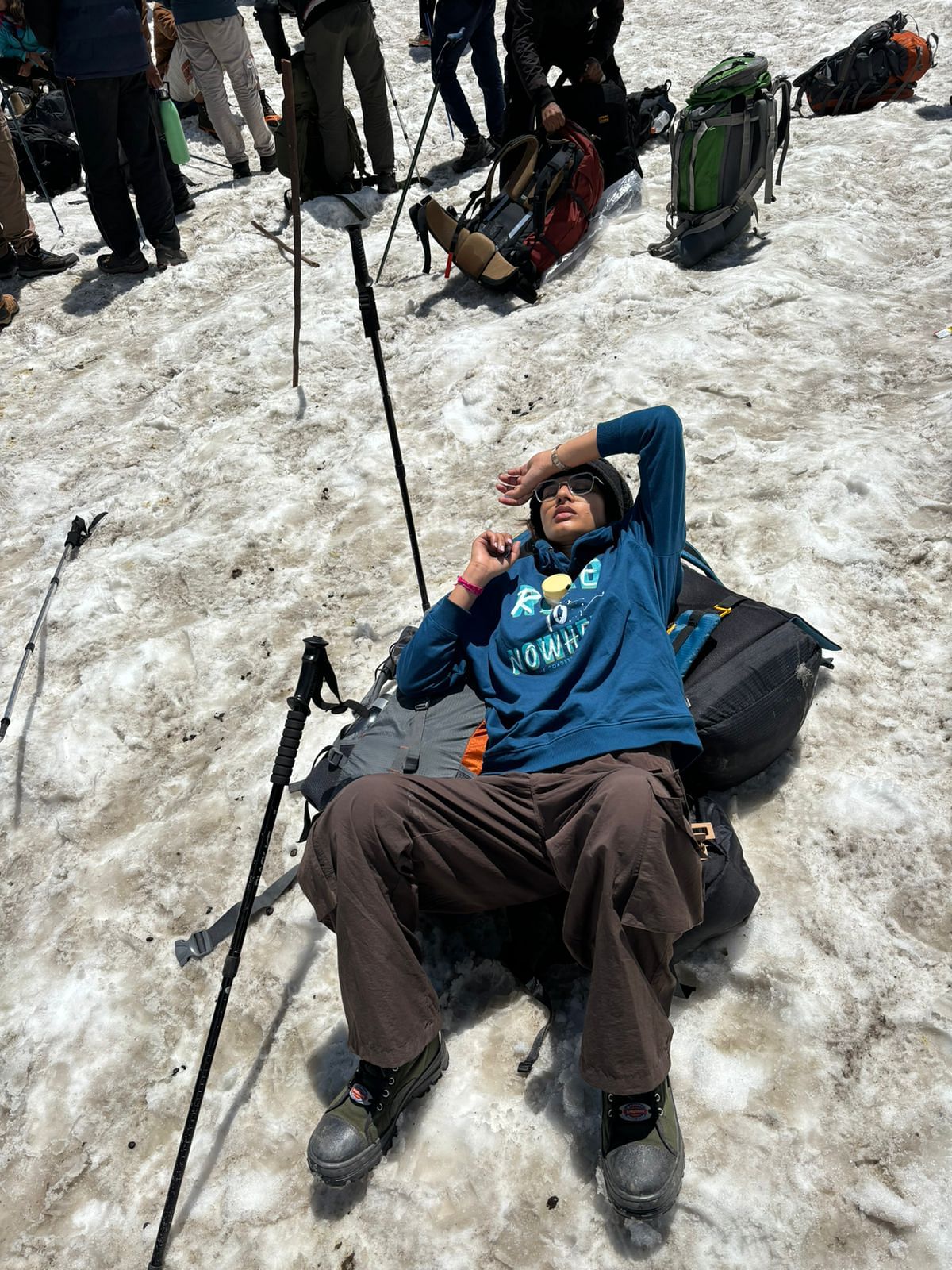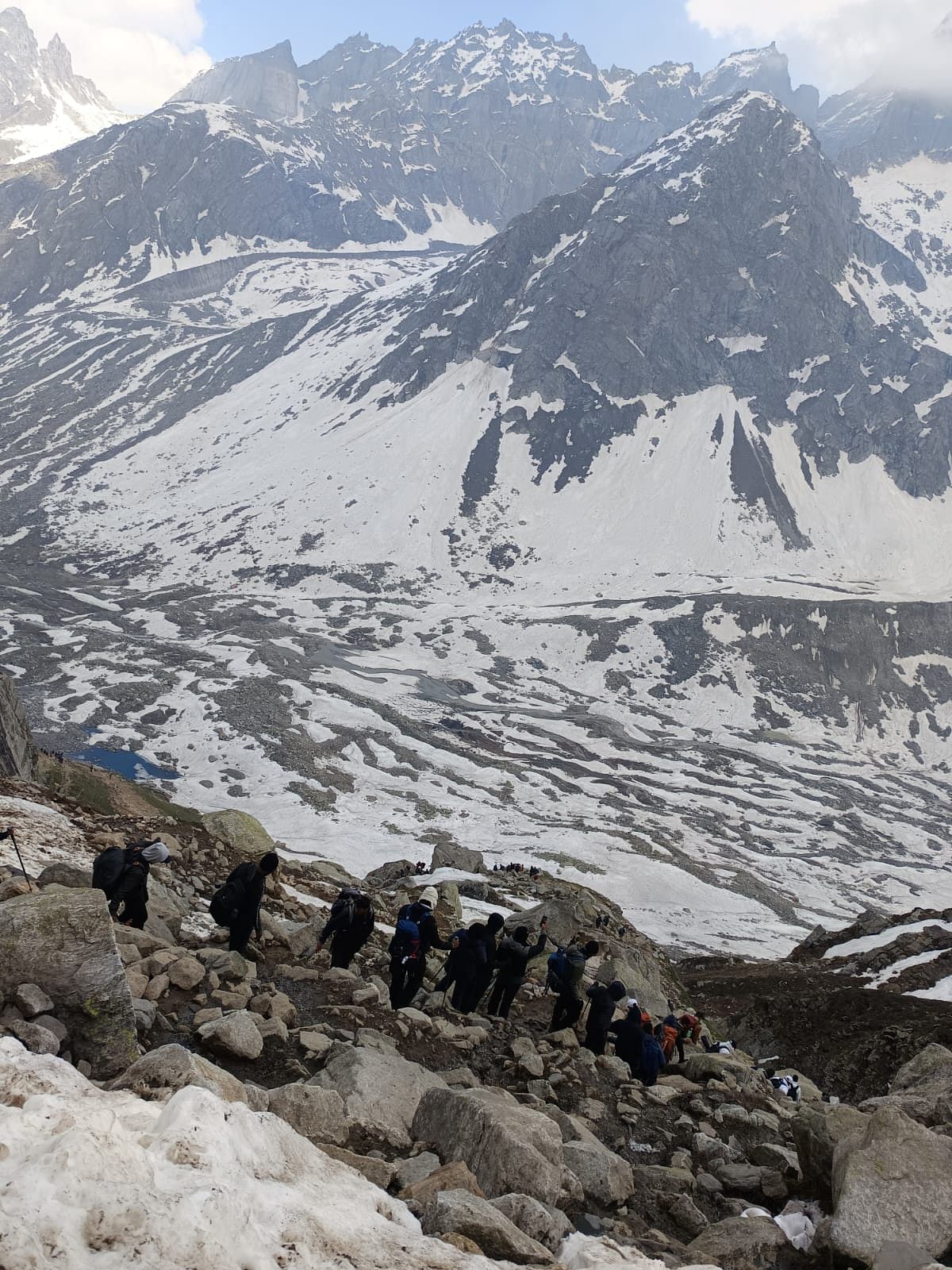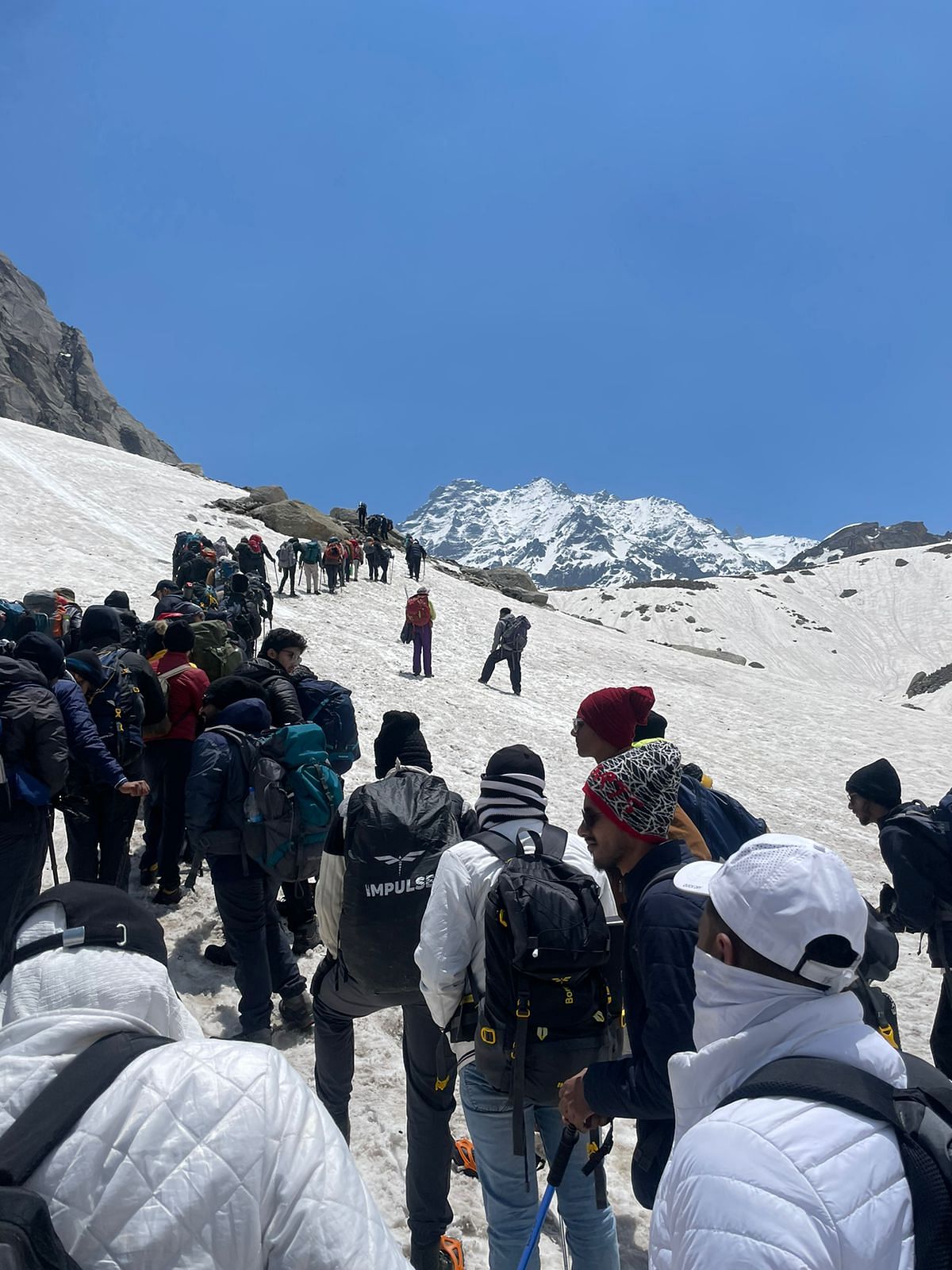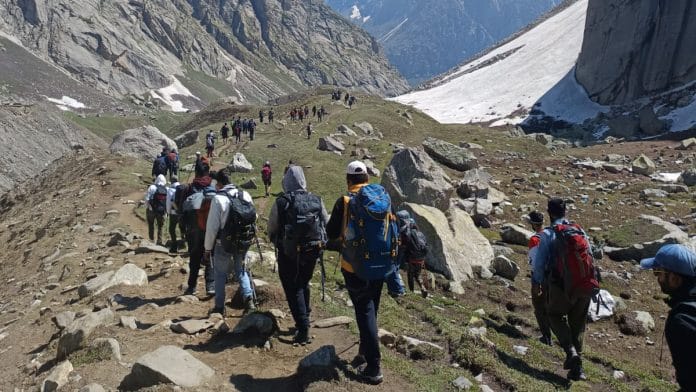New Delhi: Drenched in rain and worn out from exhaustion and hunger, Simmi Gautam’s body was turning cold. After trekking in the Himalayas for 12 hours, including navigating the tricky Hampta Pass, she collapsed and vomited at the Shea Goru camp. The travel company she booked through was nowhere to be found.
The 26-year-old fashion designer was rushed into a tent where fellow trekkers rubbed her feet and hands, applied oil to her forehead, and changed her clothes. Her oxygen levels had dropped to 52, and her pulse was fluctuating violently. “It’s a miracle she survived,” said one of the people who resuscitated her.
Simmi was part of a group of 120 people who had booked a five-day trek to Hampta Pass in Himachal Pradesh’s Spiti Valley, starting on 15 June. on the night of 17 June, at Shea Goru, nearly 100 people were stranded on a remote patch of the Himalayas without tents, as torrential rain and hail poured down, making them cold, sick, and prone to hypothermia. The night was saved by other campers and experienced trek leaders who provided first aid, food, and shelter to the abandoned group, including Simmi.
This incident occurred shortly after the Sahastra Tal snowstorm tragedy, which claimed nine lives. The issues at Sahastra Tal were similar: large groups, poor client-to-guide ratios, and a lack of preparation. What happened on and during the Hampta Pass trek underlines the pitfalls of the unregulated and unchecked expansion of India’s trekking industry, which, lured by the traffic of young people coming from big cities, often compromises on tourist safety. Cheap packages mean skipping SoPs, deploying a thin and inexperienced team of sherpas, and keeping guests in the dark about the rules of engagement of the staff.
“The trekkers were without necessary equipment, clothing, ORS, or other medical supplies. We somehow managed the situation that day; otherwise, 9-10 casualties could have been reported,” said Ganesh Katara, an experienced mountaineer who was present. He added that the group guides were inexperienced at performing CPR, didn’t know how to offer first aid, and left their group to fend for themselves. “If you are going to the Himalayas, you must prepare properly.”
Meanwhile, one of the trek leaders, Divya Thakur, said that the group of tourists were abusive, non cooperative and didn’t listen to her instructions. “I had asked the woman who suffered from Hypothermia symptoms to return to Balu Ka Gera camp, almost 300 metres before the summit since she was vomiting. But she didn’t listen to me, and snuck past me. Some members of the trek group were also drinking and smoking during camps, even though I had asked them not to,” she added.

The four companies involved—Byko Journeys, Trekyaari, Trekkers of India, and Mad Trekkers—insist they took responsibility for the situation, and had already initiated refunds.
“We had arranged a porter and khachchar wala (mule handler) at Chattru village, who promised us 28 mules. But this porter ran away with all our belongings because he got a booking to Ladakh. We are still looking for him and are considering taking criminal action,” a representative from Trekkers of India told ThePrint.
The chaos at Hampta Pass illustrates the danger of irresponsible commercial trekking, a highly unregulated and disorganised space. Unsuspecting people booked treks mostly via Instagram advertisements. The four companies then handed over the business to a local Himachali operator, who combined the four groups into a single large group of 120 people for a gruelling five-day trek at altitudes touching 4,200 metres. Byko Journeys and Trekyaari conduct daily treks to Hampta Pass, while Trekkers of India conducts weekend treks.
This mess resulted from poor coordination, ill-prepared trekkers, a large group with a poor client-to-guide ratio, and a business model that made accountability nearly impossible.
Also read: ‘Indians willing to bargain lives for cheap treks’—trekking companies have no govt oversight
A perfect mess
Ridhi Banerjee was searching for a reinvigorating trek in the Himalayas. Her search ended in an Instagram post by Trekkers of India — a four-night trek through Hampta Pass. Thrilled, she booked her bus tickets, put on her trekking shoes, carried a backpack, and hopped on an overnight bus from Delhi to Manali.
But the trek looked ominous from the start. Hundreds of people, from all over India, including Jammu, Punjab, West Bengal, and Delhi, had lined up to begin the trek. “We gathered at the 17-mile bridge, 20-30 minutes before Manali, and were supposed to start trekking at 11 am, but the trek began only at 2 pm because we were waiting for others to join,” the 35-year-old development consultant told ThePrint over the phone.
Banerjee and other trekkers said that there were three trek leaders and six local guides to shepherd the group on the tricky terrain. However, the volume of people was such that even conducting a headcount was impossible.
“Neither did we know who was in our group, nor did we know who to follow on the first day,” Banerjee added.
While Trekkers of India said they regularly send groups of 30-40, a group size of 120 was unusually large.
On the first night of camping at Chika, the camps weren’t pre-allotted to people. There were fewer tents than promised, and the trek leaders washed their hands of all responsibility.
“When we approached the trek leader, she told us she was a freelance consultant and assigning tents was not her job. Her job was to take us from point A to point B, not logistics arrangements,” Banerjee said.

People had booked tents on a triple-sharing basis, but later, five people were assigned to a single tent. The trek leaders, initially unhelpful, eventually gave away their sleeping bags.
Food distribution was also nightmarish. “They didn’t have enough food for 100 people. People went wild when food was served, pouncing on each other for a single packet. The quality and quantity were both poor,” said Akshit Sharma, a management consultant from Chandigarh, “If food was over by the time your turn came, you didn’t get any. Simple.”
As the trek progressed, 25 people left midway, drained of energy or disgruntled by the mismanagement. By the time the group reached Shea Goru, after crossing Hampta Pass, 95 people remained.
Also read: How Uttarakhand trekking turned adventure into tragedy—cost-cutting, scant resources
No camps, trek leaders flee
The trekkers reached the summit on day three of their journey, crossing the Hampta Pass at 2 pm. Like most treks, they dispersed to celebrate, but their travel partners insisted they hurry because there was no arrangement to stay at Shea Goru. They would have to trek to the last base, Chattru, about six kilometres from Shea Goru. All this as the sun was fast going down.
The trek to Chattru is not an easy one. It involves crossing the Chenab river and a ‘snow bridge’. Crossing rivers in the evening is inadvisable due to the increased flow. All four companies promise a stay at Shea Goru.
The descent from Hampta Pass to Shea Goru took two hours for some, but for slower trekkers, it took close to five hours.
“The descent was not easy. They should have arranged mules and camps from base to Shea Goru. It was the hardest day of the trek. We were exhausted and had already trekked nine kilometres through snow,” Banerjee said.
By 4 pm at Shea Goru, a hailstorm hit the trekkers. All hell broke loose. Over the next few hours, the flimsy, unregulated, and unsafe climbing tourism unravelled. People fell sick, showing symptoms of acute mountain sickness and hypothermia. Tempers ran high as panic-stricken trekkers and their travel partners indulged in blame games.
The trek leaders — Arjun Dogra, Divya, and Jyoti — who were experienced and licensed mountaineers, fled, leaving 95 travellers stranded.
“The trek leaders went to check if we could still cross the river and vanished, abandoning us,” Sharma said.
Divya said the trekkers left because they feared for their safety as their clients were verbally abusive, and one of them even charged at them with a stick.
“We crossed the river at night, which was a dangerous task for us too. We then made arrangements for stay at Chattru, but left from that camp as well because we heard word from our guides that angry trekkers were planning to surround us and hit us,” she said. Divya also accused the tourists of sending intimidating texts to her phone and commenting on her Instagram page. “We are very scared to even step out of our rooms.”
However, the trekking companies alleged that the travellers made the mess, accusing them of being frustrated, angry, and abusive. Trekkers of India alleged its trek leaders were roughed up.
“In that situation, where people were discussing to beat them up, abusing them, the trek leaders thought it best to leave,” said a representative of Mad Trekkers.

ThePrint spoke to six eyewitnesses to find out if a physical altercation had occurred. The trekkers said “they didn’t remember any physical altercation”.
As the trek leaders abandoned the group, Ganesh Katara, who was leading another expedition, came to their rescue. Katara tried to contact the trek leaders, who told him to send their group ahead.
“It was raining, it was late at night. The river was overflowing. I decided to help people camp at Shea Goru itself,” he said.
Katara and his group of 12 helped the stranded group of 95. They shared dry clothes, medicines, ORS solution, and ration with them. Simmi, who was in critical condition, said that she didn’t get proper food that day. “I was late for breakfast. When I asked the trek guide, they told me it was all over. I didn’t have energy, which is why my condition deteriorated so badly,” she said.
“Simmi would have collapsed if she wasn’t provided assistance immediately,” Katara said. At least 2-3 more people showed symptoms of hypothermia. “The entire night I was scared that someone would die,” he added.
Twenty to thirty people had to be squeezed into a single tent as temperatures dropped below zero.
“All of us were feverish, but only those with chest pain could get medicines and be tended to. I also had a fever of 102 degree Celsius,” Sharma said.
Also read: There’s a boom in senior citizens climbing the Himalayas. Risk evaluation is the first step
Not a walk in the park
Higher disposable incomes for India’s young workforce have meant more leisure time. It’s a race to the hills to earn the adventurer tag. It is this influx that has fuelled the mushrooming of travel companies that promise to give a high but without the safety net. Steep competition means operating on thin margins that contribute to safety compromises.
The average rate for a trek to Hampta Pass is Rs 7,000. Companies like the one Katara represented arrange the same trek at double the cost, Rs 14,000. Cost-cutting leads to compromised trek quality.
Treks of India, Mad Trekkers, and Byko Journeys maintain a trekker-to-guide ratio of 10:1, which is very poor. Katara’s group of 12 had four guides, a ratio of 1:4.
At the Hampta Pass trek, the companies failed to adhere to this ratio. For 120 people, there were three trek leaders and six guides, roughly 13 people per guide.
All three companies operate on a B2B model — most treks they conduct are organised by third parties, not their direct employees. Most trekkers are unaware of this distinction.
“People are risking their lives over cheap rates,” Katara said.
When asked if health checkups were conducted before the trek, Trekkers of India said they “check BP, oxygen levels, and pulse rate” before the trek starts, while Byko Journeys said: “We get a medical declaration form filled where people have to disclose their comorbidities. We don’t take people on the trek without this information.”
Katara expressed frustration at both the companies and the trekkers. “People showed up as if it was a walk in the park. They didn’t have proper gear or clothes, and showed up without training. Some were walking in canvas shoes while others wore jeans,” Katara told ThePrint.
The lack of accountability added to the trekkers’ frustration. “We didn’t know who was hired by which company. The trek leaders were freelancers, the drivers were freelancers, local guides were freelancers, and the companies couldn’t say much except refund our money!” Banerjee said.
Sharma, who had booked a trek with Trekyaari, said the company initiated a refund even though they didn’t want it. “We made it clear in our verbal conversations that we didn’t want a refund until we had further conversations,” Sharma said.
Queries sent to Trekyaari via emails went unanswered.
The companies maintained they had no idea their local operator had merged the various groups. There was also no clarity on who the trek leaders were appointed by.
“The trek leaders were our employees, but they took responsibility for all 100 people from different companies,” Mad Trekkers said, while Trekkers of India claimed all three trek leaders were on their payroll.
The refund also came with a caveat. Trekkers of India sent WhatsApp messages to their clients, saying the client couldn’t “defame” the company and could not sue them. “The trekker/client waives any legal action against Trekkers of India, its employees or its vendors,” the message read.
Trekkers of India maintained that clients were physically and verbally abusive and demanded compensation of up to Rs 1 lakh. “We sent a very normal message,” a company representative said.
The group of trekkers, including Simmi Gautam, has formed a WhatsApp group and is planning legal action against the companies.
The companies, meanwhile, are searching for the sacrificial lamb—the mule owner from Chattru village, who is absconding with all their trekking gear.
(Edited by Prashant)







Hello Print, please ask the trek organisers that how comes the incident repeated on the very next day also ? Only difference there was no casualty. Their next batch trekked Balu ka ghera -> Hamta Pass -> directly to Chatru in one day i.e., on 18.06.2024 as there was no tents in Shea Goru . In heavy rain, they had to take shelter in other organiser’s mess tent at Shea Goru.They were also exhausted but had to trek down further as no other options were there. The last batch reached Chatru at night 2AM